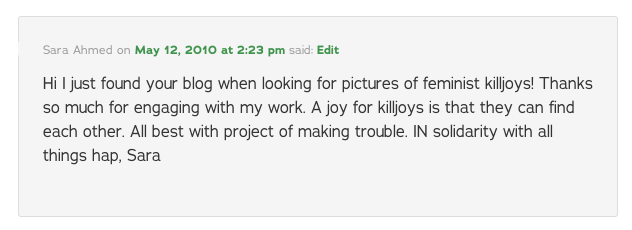In honor of the third anniversary of this blog (this Saturday!), I’m looking back to some of my greatest hits and most memorable posts. Yesterday I posted about year one: May 2009-April 2010; today I’m posting about year two.
Greatest Hits
1. Being Beside Oneself with Grief, part 2/ May 26, 2010/ 697 hits
2. Sara Ahmed and The Promise of Happiness/ December 18. 2010/ 263 hits
3. Caring too much (or not enough)? The virtue and vices of caring/ July 7, 2010/ 230 hits
4. Playgrounds, kids and making trouble/ July 18, 2010/ 184 hits
5. Being Beside Oneself with Grief/ May 20, 2010/ 174 hits
6. Agonism, Criticism and the Trouble with Fault Finding/ June 16, 2010/ 154 hits
some favorite posts
1. The trouble with clowns/ May 16, 2010
I still want this book. Hmmm….Mother’s Day is coming up. 
2. My Trouble with Mother’s Day/ May 12, 2010
In this post, I document my process of writing an academic article about my mom’s death (that article was published later that year). Using the blog to write about the process and the article was an amazing experience. It allowed me to share my ideas and experiences with more people and to document my earliest efforts at trying to work through and make sense of my grief.
3. The Value of Failure: Versions 1, 2 and 3/ July 13. 2010
In this experimental blog post, I offered up my reflection on failure as they related to each of the three blogs that I was working on during the summer of 2010. In retrospect, it was a little crazy to try to do all of these blogs at once…but I sometimes go a little crazy in my experiments online. Anyway, here’s the description that I gave:
Right now I am attempting to juggle three different blogs. I really like how they highlight different aspects of my writing/thinking/feeling self. On trouble, I focus on giving critical (and serious, extended) attention to trouble in feminist and queer contexts. Frequently I write about Judith Butler and the ethical implications of her work. I also devote a lot of time to working through my own (hopefully) book project on trouble as a virtue. On Unchained, I experiment with developing/practicing virtue ethics (in relation to breaking, reworking, transforming consumption habits) through and in connection with blogging. I co-write this blog with my partner, STA, as we try to figure out ways to reduce consumption, make better (whatever that means) choices, and model “good” behavior for two crazy, yet wonderful kids, FWA and RJP. Finally on It’s Diablogical!, I diablogue with my writing partner and good friend, KCF, about blogging and feminist pedagogy. Our blog is part of a larger writing project on teaching with blogs and blogging while teaching.
Since writing this post, KCF and I have published a book chapter based on our writing project blog and STA and I have moved on from the Unchained blog (my last post there: November, 2010) to a more successful collaboration: the podcast, The Undisciplined Room.
4. The Trouble with Valentine’s Day/ February 13, 2011
I think this post was one of the first experiments in putting my lecture online for the class (or did I do this earlier?). I don’t think this was that successful for the students. Partly, I think, because this was a huge class and partly because the students, most of whom were new to GWSS (gender, women, sexuality studies) classes, were resistant to troubling Valentine’s Day. While it didn’t work as part of an in-class lecture, I’m still happy with the post and the amount of questions I was able to pose and connections I was able to make. An added bonus for this post was that I used it to develop another version of who I am as a queer feminist troublemaker. Here’s what I wrote (which I recently added to my about me page):
My vision of feminist/queer thinking links MAKING TROUBLE FOR (questioning, unsettling, exposing, challenging, resisting, reframing) categories, ideas, practices, norms, institutions with the need for DEVELOPING AND PROMOTING A CRITICAL AWARENESS of how our everyday practices are shaped by and contribute to larger structures of oppression, power and privilege. While straight thinking encourages us to understand our everyday experiences from our particular social/cultural locations as “natural” or “normal” and breaks them down into rigid binaries (male/female, heterosexual/homosexual, white/non-white) with one half of the binary privileged over the other, feminist/queer thinking encourages us to question, play with and “bust” these binaries. It also encourages us to make connections, to find patterns and to be curious about why things are they way they are and how they might be transformed. And it encourages us to ask who benefits from this “natural” order and at whose expense is it perpetuated.
While my version of feminist/queer thinking is inspired by lots of folks, here are three thinkers that are inspiring me right now as I work to articulate my vision of politics for my “politics of sex” class:
Cynthia Enloe and her emphasis, especially within her introduction to The Curious Feminist, on the value of having a feminist curiosity and of engaging in the difficult labor of questioning practices, institutions, ideologies that claim to be “natural,” “normal,” or just part of “tradition.” These acts of curiosity potentially enable us to expose the larger structures (of patriarchy, racism, heterosexism) that undergird those seemingly unquestionable claims to the natural or normal.
bell hooks and her discussion, especially in Feminism is for Everybody and Teaching to Transgress, of the importance of critical awareness and making connections between our everyday practices and larger structures of power, privilege and oppression.
Cathy Cohen and her discussion of the radical potential of queer politics in her essay, “Punks, Bulldaggers and Welfare Queens.” Challenging a narrow (and straight?) version of heteronormativity as one the reproduces the binary between straight and queer, Cohen argues that while heteronormativity might be a
“primary system of power structuring our lives, it [heteronormativity] interacts with institutional racism, patriarchy, and class exploitation to define us in numerous ways as marginal and oppressed subjects” (31).
So, moving beyond straight thinking requires that we also think about more than sexuality; we must put our discussions about sex/sexuality/sexual politics into conversation with discussions of race, gender and class. We need to move beyond the single oppression model that narrows our vision and limits our ability to make connections across differences.


